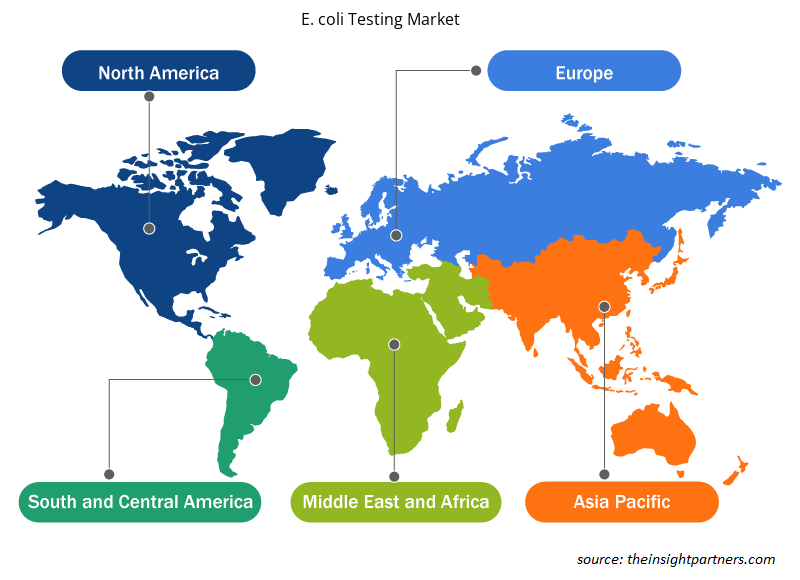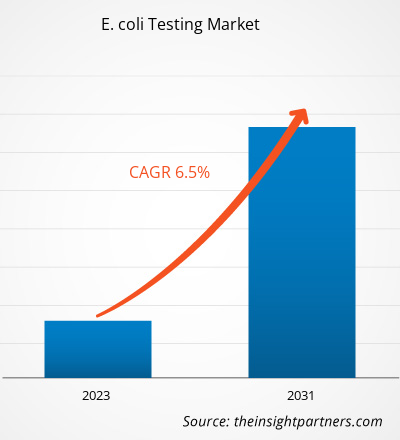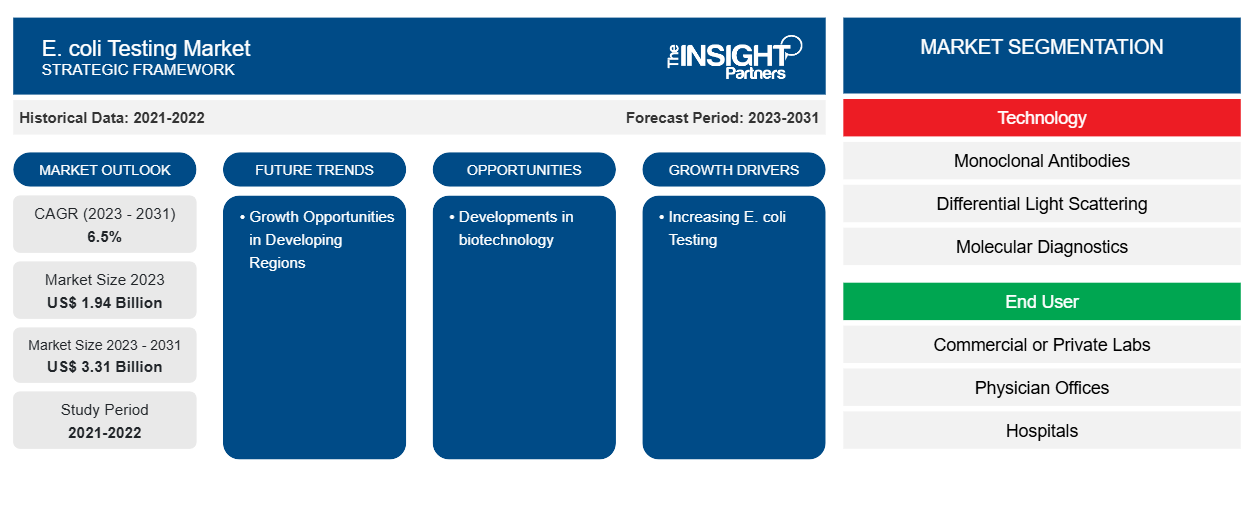El mercado de pruebas de E. coli se valoró en 1.940 millones de dólares estadounidenses en 2023 y se espera que alcance los 3.310 millones de dólares estadounidenses en 2031. Se espera que el mercado registre una CAGR del 6,5 % entre 2023 y 2031. Los avances en biotecnología probablemente seguirán siendo una tendencia clave en el mercado de pruebas de E. coli.
Análisis del mercado de pruebas de E. coli
Las bacterias Escherichia coli (E. coli) son bacterias gramnegativas con forma de bastón que se encuentran generalmente en los alimentos, el medio ambiente y los intestinos de los animales de sangre caliente. La mayoría de las cepas de E. coli son inofensivas para los seres humanos. Sin embargo, algunas cepas se reconocen como la causa de complicaciones médicas graves, como infecciones del tracto gastrointestinal, colecistitis, colangitis, meningitis neonatal, bacteriemia, neumonía, infección del tracto urinario (ITU) y se propagan regularmente a través de alimentos o agua contaminados. Se espera que los factores clave que impulsan el mercado, como el aumento de las pruebas de E. coli, la creciente innovación de productos y el aumento de las actividades de investigación, impulsen el crecimiento del mercado. Sin embargo, los desafíos de las pruebas son el principal factor que obstaculiza el crecimiento del mercado.
Descripción general del mercado de pruebas de E. coli
La concienciación sobre la higiene, las estrictas regulaciones gubernamentales y la presencia de todos los actores regionales clave son los principales factores impulsores de este mercado. Además, el alto gasto en I+D para desarrollar nuevos productos de diagnóstico y una infraestructura sofisticada son factores destacados que impulsan el crecimiento del mercado. Además, el aumento de la financiación gubernamental para la infraestructura sanitaria y los avances tecnológicos en los procedimientos de diagnóstico de E. coli, los principales actores del mercado en los EE. UU. y la concienciación sobre la higiene impulsan el crecimiento del mercado.
Personalice este informe según sus necesidades
Obtendrá personalización en cualquier informe, sin cargo, incluidas partes de este informe o análisis a nivel de país, paquete de datos de Excel, así como también grandes ofertas y descuentos para empresas emergentes y universidades.
-
Obtenga las principales tendencias clave del mercado de este informe.Esta muestra GRATUITA incluirá análisis de datos, desde tendencias del mercado hasta estimaciones y pronósticos.
Factores impulsores y oportunidades del mercado de pruebas de E. coli
Aumento de las pruebas de E. coli
Escherichia coli is a large group of foodborne bacteria found in food, the environment, and the intestines of animals and humans. Although most types of E coli are harmless and help keep the digestive tract healthy, a few strains can cause tract infections, respiratory illness, and pneumonia, among others. Most instances of food poisoning and infectious diseases is caused due to E. coli. Therefore, detecting the concentration E. coli in various products is essential. Apart from industrial sectors such as pharmaceutical, biotechnology, and environmental, the food & beverages sector is at a higher risk of E coli contamination. Food & beverage companies must detect and monitor the presence of the bacteria before starting production, during the production process, and in the final products.
Growth Opportunities in Developing Regions– An Opportunity in E. coli Testing Market
Regions such as Asia Pacific, the Middle East, Africa, and Latin America are developing their healthcare sector faster. The countries are exploring new techniques by collaborating with well-established biotechnology organizations in the developed regions. Countries such as India, Brazil, the UAE, Saudi Arabia, and South Korea have increased their investments for the development biotechnology sector. For instance, the UAE government launched a project called DuBiotech, or Dubai Biotechnology and Research Park in 2005.
The government has invested US$ 35.4 million (AED 130 million) in infrastructure and US$ 163.4 million (AED 600 million) in laboratories and headquarters buildings. Likewise, the Department of Biotechnology in India is expected to make the Indian Biotechnology industry worth US$ 100 billion by 2025. Thus, rising investments in the biotechnology sector are expected to drive growth opportunities for E. coli testing services and facilities in developing regions. In addition, the regions have rising numbers of biotechnology start-ups contributing to developing the biotechnology sector. Various start-ups have launched their innovative products and services in the biotechnology field, which is expected to influence the market growth during the forecast period.
E. coli Testing Market Report Segmentation Analysis
Key segments that contributed to the derivation of the E. coli testing market analysis are disorder and service providers.
- Based on test technology, the E. coli testing market is segmented into monoclonal antibodies, differential light scattering, molecular diagnostics, immunoassays, chromatography, flow cytometry, gel microdroplets, and diagnostic imaging. The monoclonal antibodies segment held a larger market share in 2023.
- By end users, the E. coli testing market is segmented into commercial or private labs, physician offices, hospitals, public health labs, academic research institutes. The public health labs segment held the largest share of the market in 2023.
E. coli Testing Market Share Analysis by Geography
The geographic scope of the E. coli testing market report is mainly divided into five regions: North America, Asia Pacific, Europe, Middle East & Africa, and South America/South & Central America.
In North America, the U.S. is the largest market for E. coli testing. The growth of this market is primarily driven by increased government funding for healthcare infrastructure and technological advancement in E. coli diagnostic procedures; the presence of major market players in the U.S. and awareness regarding hygiene will accelerate the growth of this market in this country.
E. coli O157:H7 is one of the strains and produces a toxin known as Shiga. It is one of the most powerful toxins, and it can cause an intestinal infection. According to the North Carolina Department of Health and Human Services, some 265,000 Shiga toxin-producing E. coli (STEC) infections occur yearly in the United States (U.S.). Around 36 percent of these are probably caused by E. coli O157:H7. Moreover, UTIs result in approximately 8 million physician visits and over 100,000 hospitalizations in the United States, with an associated annual cost of $1.6 billion.
E. coli Testing Market Regional Insights
The regional trends and factors influencing the E. coli Testing Market throughout the forecast period have been thoroughly explained by the analysts at Insight Partners. This section also discusses E. coli Testing Market segments and geography across North America, Europe, Asia Pacific, Middle East and Africa, and South and Central America.

- Get the Regional Specific Data for E. coli Testing Market
E. coli Testing Market Report Scope
| Report Attribute | Details |
|---|---|
| Market size in 2023 | US$ 1.94 Billion |
| Market Size by 2031 | US$ 3.31 Billion |
| Global CAGR (2023 - 2031) | 6.5% |
| Historical Data | 2021-2022 |
| Forecast period | 2023-2031 |
| Segments Covered |
By Technology
|
| Regions and Countries Covered |
North America
|
| Market leaders and key company profiles |
|
E. coli Testing Market Players Density: Understanding Its Impact on Business Dynamics
El mercado de pruebas de E. coli está creciendo rápidamente, impulsado por la creciente demanda de los usuarios finales debido a factores como la evolución de las preferencias de los consumidores, los avances tecnológicos y una mayor conciencia de los beneficios del producto. A medida que aumenta la demanda, las empresas amplían sus ofertas, innovan para satisfacer las necesidades de los consumidores y aprovechan las tendencias emergentes, lo que impulsa aún más el crecimiento del mercado.
La densidad de actores del mercado se refiere a la distribución de las empresas o firmas que operan dentro de un mercado o industria en particular. Indica cuántos competidores (actores del mercado) están presentes en un espacio de mercado determinado en relación con su tamaño o valor total de mercado.
Las principales empresas que operan en el mercado de pruebas de E. coli son:
- LABORATORIOS BIO-RAD INC.
- Diagnóstico de laboratorio profesional inc.
- Abad
- LABORATORIOS IDEXX, INC.
- BIOCIENCIA MERIDIANA, INC.
- TERMO FISHER CIENTIFIC INC
Descargo de responsabilidad : Las empresas enumeradas anteriormente no están clasificadas en ningún orden particular.

- Obtenga una descripción general de los principales actores clave del mercado de pruebas de E. coli
Noticias y desarrollos recientes del mercado de pruebas de E. coli
El mercado de pruebas de E. coli se evalúa mediante la recopilación de datos cualitativos y cuantitativos posteriores a la investigación primaria y secundaria, que incluye publicaciones corporativas importantes, datos de asociaciones y bases de datos. A continuación, se incluye una lista de los avances en el mercado de pruebas de E. coli:
- El kit de análisis de agua para detectar E. coli, basado en un medio enzimático-sustrato, fue creado por investigadores del Instituto Indio de Tecnología (IIT) de Kanpur. Puede identificar si E. coli está presente o no en el agua potable. (Fuente: Artículo de investigación, 2022).
- Para comprender mejor la diversidad y los efectos de las mismas bacterias, los investigadores de la Universidad Estatal de Michigan experimentaron con Escherichia coli. Según los investigadores, este experimento demuestra que las ventajas de la variedad temprana se perdieron rápidamente a lo largo de las generaciones posteriores, lo que indica que las mutaciones aleatorias sirven como catalizador principal para la evolución de E. coli. (Fuente: Universidad Estatal de Michigan, comunicado de prensa, 2022).
Informe de mercado sobre pruebas de E. coli: cobertura y resultados
El informe “Tamaño y pronóstico del mercado de pruebas de E. coli (2021-2031)” proporciona un análisis detallado del mercado que cubre las siguientes áreas:
- Tamaño del mercado y pronóstico a nivel global, regional y nacional para todos los segmentos clave del mercado cubiertos bajo el alcance
- Dinámica del mercado, como impulsores, restricciones y oportunidades clave
- Principales tendencias futuras
- Análisis detallado de las cinco fuerzas de Porter y PEST y FODA
- Análisis del mercado global y regional que cubre las tendencias clave del mercado, los principales actores, las regulaciones y los desarrollos recientes del mercado.
- Análisis del panorama de la industria y de la competencia que abarca la concentración del mercado, el análisis de mapas de calor, los actores destacados y los desarrollos recientes
- Perfiles detallados de empresas
- Análisis histórico (2 años), año base, pronóstico (7 años) con CAGR
- Análisis PEST y FODA
- Tamaño del mercado, valor/volumen: global, regional y nacional
- Industria y panorama competitivo
- Conjunto de datos de Excel
Informes recientes
Informes relacionados
Testimonios
Razón para comprar
- Toma de decisiones informada
- Comprensión de la dinámica del mercado
- Análisis competitivo
- Información sobre clientes
- Pronósticos del mercado
- Mitigación de riesgos
- Planificación estratégica
- Justificación de la inversión
- Identificación de mercados emergentes
- Mejora de las estrategias de marketing
- Impulso de la eficiencia operativa
- Alineación con las tendencias regulatorias























 Obtenga una muestra gratuita para - Mercado de pruebas de E. coli
Obtenga una muestra gratuita para - Mercado de pruebas de E. coli